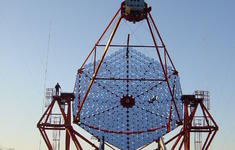Home > Science Capability Building > Africa’s growing science capacity: Recent Scientific Breakthroughs in Africa Science Capability Building
Africa’s growing science capacity: Recent Scientific Breakthroughs in Africa
The MeerKat project has in particular demonstrated the growing innovative capacity of local engineers in creating world-class hardware. The development of the hardware to process the signal for the telescope is an example of cutting-edge technology that was designed in South Africa. The ROACH - Reconfigurable Open Architecture Computing Hardware is central to the project - and the second generation hardware will be manufactured by a local South African company.
In 2005, it was announced that H.E.S.S. had detected eight new high-energy gamma ray sources, doubling the known number of such sources. Two of these sources could not be identified with known objects such as supernova remnants or pulsars, raising the possibility of new physics and the existence of some new "dark" objects.
More recently, South Africa completed the experiment of the "detection of the fringes" in a joint very long baseline interferometry observation, without assistance from other countries. The 26m Hartebeesthoek Radio Astronomy Observatory, near Pretoria, teamed up with one of the 12m dishes currently part of the Karoo Array Telescope, to jointly observe and record data from a distant radio source known as 3C273. The data was subsequently correlated in Cape Town to produce the first ever African fringe detection, at its first attempt.
Coordination is provided by ISC Intelligence in Science as one of the initiators of AERAP, together with the South African Mission to the EU.
Contact: info@aerap.org or +32 2 8888 111

 Search the Website
Search the Website